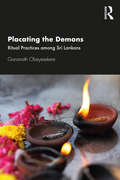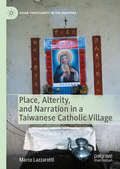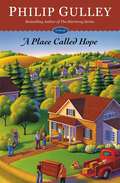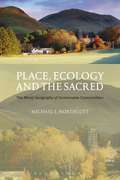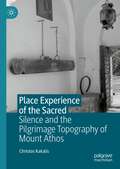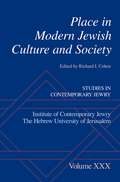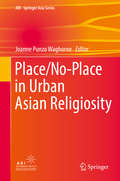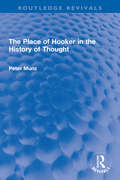- Table View
- List View
Pivot Patterns in the Former Prophets (The Library of Hebrew Bible/Old Testament Studies)
by Nathan KlausThe 'pivot pattern' is a unique type of chiasmus, a linguistic pattern characterized by an inversion of the internal order of a phrase or passage. The main idea is found primarily at its pivot, while its elements, normally of an uneven number, are distributed on both sides of the pivot in a mirrored symmetry. Klaus undertakes here to compile a 'grammar' of the pattern, and to characterize, exemplify and differentiate its various forms.
Placating the Demons: Ritual Practices among Sri Lankans
by Gananath ObeyesekereThis book critically examines dominant ceremonial practices in Sri Lanka. It presents key ideas and symbolic systems that exist to this day, in similar shapes or in different guises. It looks at issues such as misfortunes caused by demons (yaksa dosa), an important ceremonial practice known as the puna-yāgaya, ideas pertaining to spirit possession, trance, and mediums. It also deals with classical Ayurvedic theories of disease, urban ceremonial practices such as cases of the apotheoses from demon to divinity, as well as multiple forms of Buddhist ceremonial practices that are part of the Sri Lankan consciousness and have found their way into public cultural performances in Sri Lanka. As a comprehensive volume on ceremonial practices in Sri Lanka, this work will be useful for scholars and researchers in cultural studies, sociology, social-anthropology, and particularly those interested in myths and rituals in South Asia.
Placating the Demons: Ritual Practices among Sri Lankans
by Gananath ObeyesekereThis book critically examines dominant ceremonial practices in Sri Lanka. It presents key ideas and symbolic systems that exist to this day, in similar shapes or in different guises. It looks at issues such as misfortunes caused by demons (yaksa dosa), an important ceremonial practice known as the puna-yāgaya, ideas pertaining to spirit possession, trance, and mediums. It also deals with classical Ayurvedic theories of disease, urban ceremonial practices such as cases of the apotheoses from demon to divinity, as well as multiple forms of Buddhist ceremonial practices that are part of the Sri Lankan consciousness and have found their way into public cultural performances in Sri Lanka. As a comprehensive volume on ceremonial practices in Sri Lanka, this work will be useful for scholars and researchers in cultural studies, sociology, social-anthropology, and particularly those interested in myths and rituals in South Asia.
Place, Alterity, and Narration in a Taiwanese Catholic Village (Asian Christianity in the Diaspora)
by Marco LazzarottiThis book introduces a simple idea: when we tell a story, we tell a story and at the same time create the world where this story takes place. Narration creates environments, spaces and, in a certain sense, gives symbolic meanings and values to the identities by which people interact in their daily experiences. Set in the multicultural and multireligious Taiwanese environment, this book describes the interactions, and above all the narrations, linked to a Catholic village located in the Taiwanese countryside. Catholicism in Taiwan is a minor religion (around 2% of the population), and considered a foreign and heterodox religion, something different and "other" from the Taiwanese mainstream religious environment. It is this sense of alterity that creates the stories about this place and, as a consequence, creates this place and its special identity.
Place and Dialectic: Two Essays by Nishida Kitaro (AAR Religions in Translation)
by John W. M. Krummel Shigenori NagatomoPlace and Dialectic presents two essays by Nishida Kitaro, translated into English for the first time by John W.M. Krummel and Shigenori Nagatomo. Nishida is widely regarded as one of the father figures of modern Japanese philosophy and as the founder of the first distinctly Japanese school of philosophy, the Kyoto school, known for its synthesis of western philosophy, Christian theology, and Buddhist thought. The two essays included here are ''Basho'' from 1926/27 and ''Logic and Life'' from 1936/37. Each essay is divided into several sections and each section is preceded by a synopsis added by the translators. The first essay represents the first systematic articulation of Nishida's philosophy of basho, literally meaning ''place,'' a system of thought that came to be known as ''Nishida philosophy.'' In the second essay, Nishida inquires after the pre-logical origin of what we call logic, which he suggests is to be found within the dialectical unfoldings of world history and human society. A substantial introduction by John Krummel considers the significance of Nishida as a thinker, discusses the key components of Nishida's philosophy as a whole and its development throughout his life, and contextualizes the translated essays within his oeuvre. The Introduction also places Nishida and his work within the historical context of his time, and highlights the relevance of his ideas to the global circumstances of our day. The publication of these two essays by Nishida, a major figure in world philosophy and the most important philosopher of twentieth-century Japan, is of significant value to the fields not only of Asian philosophy and East-West comparative philosophy but also of philosophy in general as well as of theology and religious studies.
Place and Identity in the Lives of Antony, Paul, and Mary of Egypt: Desert as Borderland (Religion and Spatial Studies)
by Peter Anthony MenaIn this book, Peter Anthony Mena looks closely at descriptions of space in ancient Christian hagiographies and considers how the desert relates to constructions of subjectivity. By reading three pivotal ancient hagiographies—the Life of Antony, the Life of Paul the Hermit, and the Life of Mary of Egypt—in conjunction with Gloria Anzaldúa’s ideas about the US/Mexican borderlands/la frontera, Mena shows readers how descriptions of the desert in these texts are replete with spaces and inhabitants that render the desert a borderland or frontier space in Anzaldúan terms. As a borderland space, the desert functions as a device for the creation of an emerging identity in late antiquity—the desert ascetic. Simultaneously, the space of the desert is created through the image of the saint. Literary critical, religious studies, and historical methodologies converge in this work in order to illuminate a heuristic tool for interpreting the desert in late antiquity and its importance for the development of desert asceticism. Anzaldúa’s theories help guide a reading especially attuned to the important relationship between space and subjectivity.
Place and Post-Pandemic Flourishing: Disruption, Adjustment, and Healthy Behaviors (SpringerBriefs in Psychology)
by Victor Counted Richard G. Cowden Haywantee RamkissoonThis book rekindles the well-known connection between people and place in the context of a global pandemic. The chapters are divided into two sections. In the first section, “Place Attachment During a Pandemic,” we review the nature of the COVID-19 pandemic and the extent of its impact on place attachment and human-environment interactions. We examine how restrictions in mobility and environmental changes can have a significant psychological burden on people who are dealing with the effect of place attachment disruption that arises during a pandemic. In the second section, “Adjusting to Place Attachment Disruption During and After a Pandemic,” we focus on adaptive processes and responses that could enable people to adjust positively to place attachment disruption. We conclude the book by discussing the potential for pro-environmental behavior to promote place attachment and flourishing in the aftermath of the COVID-19 pandemic by introducing an integrative framework of place flourishing and exploring its implications for theory, research, policy, and practice.
A Place at the Altar: Priestesses in Republican Rome
by Meghan J. DiluzioA Place at the Altar illuminates a previously underappreciated dimension of religion in ancient Rome: the role of priestesses in civic cult. Demonstrating that priestesses had a central place in public rituals and institutions, Meghan DiLuzio emphasizes the complex, gender-inclusive nature of Roman priesthood. In ancient Rome, priestly service was a cooperative endeavor, requiring men and women, husbands and wives, and elite Romans and slaves to work together to manage the community's relationship with its gods.Like their male colleagues, priestesses offered sacrifices on behalf of the Roman people, and prayed for the community’s well-being. As they carried out their ritual obligations, they were assisted by female cult personnel, many of them slave women. DiLuzio explores the central role of the Vestal Virgins and shows that they occupied just one type of priestly office open to women. Some priestesses, including the flaminica Dialis, the regina sacrorum, and the wives of the curial priests, served as part of priestly couples. Others, such as the priestesses of Ceres and Fortuna Muliebris, were largely autonomous.A Place at the Altar offers a fresh understanding of how the women of ancient Rome played a leading role in public cult.
A Place at the Altar: Priestesses in Republican Rome (PDF)
by Meghan J. DiluzioA Place at the Altar illuminates a previously underappreciated dimension of religion in ancient Rome: the role of priestesses in civic cult. Demonstrating that priestesses had a central place in public rituals and institutions, Meghan DiLuzio emphasizes the complex, gender-inclusive nature of Roman priesthood. In ancient Rome, priestly service was a cooperative endeavor, requiring men and women, husbands and wives, and elite Romans and slaves to work together to manage the community's relationship with its gods.Like their male colleagues, priestesses offered sacrifices on behalf of the Roman people, and prayed for the community’s well-being. As they carried out their ritual obligations, they were assisted by female cult personnel, many of them slave women. DiLuzio explores the central role of the Vestal Virgins and shows that they occupied just one type of priestly office open to women. Some priestesses, including the flaminica Dialis, the regina sacrorum, and the wives of the curial priests, served as part of priestly couples. Others, such as the priestesses of Ceres and Fortuna Muliebris, were largely autonomous.A Place at the Altar offers a fresh understanding of how the women of ancient Rome played a leading role in public cult.
A Place at The Table: Faith, hope and hospitality
by Jo Swinney Miranda HarrisAt a time when loneliness and isolation have reached unprecedented levels, it has never been more important for Christians to embrace the practice of hospitality. For many, it is a lost art - a practice we have forgotten, neglected or distorted beyond all recognition. Amid material comforts and rife individualism, practising hospitality can often hold unrealistic expectations and insurmountable pressure. But what if the practice of hospitality was simpler and yet more profound than we imagined? From the simple act of preparing vegetables to the warm welcome of a stranger, co-authors Miranda Harris and her daughter Jo Swinney re-define hospitality for the modern age. Drawing on biblical insights and a deep well of experience - most significantly within the community in the A Rocha family - this is a warm invitation to embrace the loving kindness of others. To be hospitable doesn't require culinary excellence or matching cutlery - it doesn't even require a home of one's own; true hospitality offers a welcome into imperfection and messiness, a place to belong and be embraced. Following the progression of a meal, from its planning to the moment every guest has departed, A PLACE AT THE TABLE is a heart-warming invitation into a life of thoughtful food preparation, shared meals and meaningful conversation.
A Place Called Hope: A Novel (Hope #1)
by Philip GulleyWhen Quaker Pastor Sam Gardner is asked by the ill Unitarian minister to oversee a wedding in his place, Sam naturally agrees. It's not until the couple stands before him that he realizes they're two women. In the tempest of strong opinions and misunderstandings that follows the incident, Sam faces potential unemployment. Deeply discouraged, he wonders if his pastoral usefulness has come to an end. Perhaps it's time for a change. After all, his wife has found a new job at the library, his elder son is off to college, and the younger has decided to join the military once he graduates high school. Sam is contemplating a future selling used cars when he receives a call from a woman in the suburban town of Hope, Indiana. It seems Hope Friends Meeting is in desperate need of a pastor. Though they only have twelve members, they also have a beautiful meetinghouse and a pie committee (Sam is fond of pie). But can he really leave his beloved hometown of Harmony?
A Place Called Hope: A Novel (Hope #1)
by Philip GulleyWhen Quaker Pastor Sam Gardner is asked by the ill Unitarian minister to oversee a wedding in his place, Sam naturally agrees. It's not until the couple stands before him that he realizes they're two women. In the tempest of strong opinions and misunderstandings that follows the incident, Sam faces potential unemployment. Deeply discouraged, he wonders if his pastoral usefulness has come to an end. Perhaps it's time for a change. After all, his wife has found a new job at the library, his elder son is off to college, and the younger has decided to join the military once he graduates high school. Sam is contemplating a future selling used cars when he receives a call from a woman in the suburban town of Hope, Indiana. It seems Hope Friends Meeting is in desperate need of a pastor. Though they only have twelve members, they also have a beautiful meetinghouse and a pie committee (Sam is fond of pie). But can he really leave his beloved hometown of Harmony?
Place, Catholicism and Violence: The Construction of Place in Caracas’ Barrios
by Gabriela Quintana VigiolaThis book explores the interwoven nature of place, Catholicism and violence in Caracas’ barrios. Using interdisciplinary perspectives to investigate themes of urban space, meaning as a psychosocial construct, criminal violence, and religiosity as culture, this book uncovers the underlying complexities of turning spaces into places through the built form, activities in the urban space and the meanings associated with it. Fundamental elements in the construction of place are used to understand the ways in which barrio residents conceive and construct the physicality of the private, public and religious spaces; how residents use the physical spaces of the barrios; and the psychosocial meanings residents associate with the spaces and activities. Using rich qualitative data and a case study design, the book relies on audio-visual data and interviews with organisers, residents and key participants in Petare, the largest barrio conglomeration in Caracas and Venezuela. Qualitative thematic analysis of participants’ experiences of Catholicism, violence and, ultimately, the construction of place exposes a unique argument: that meaningful urban spaces are embedded with emotions, memories, relationships, experiences and meanings, which turn them into places.
Place, Ecology and the Sacred: The Moral Geography of Sustainable Communities
by Michael S. NorthcottPeople are born in one place. Traditionally humans move around more than other animals, but in modernity the global mobility of persons and the factors of production increasingly disrupts the sense of place that is an intrinsic part of the human experience of being on earth. Industrial development and fossil fuelled mobility negatively impact the sense of place and help to foster a culture of placelessness where buildings, fields and houses increasingly display a monotonous aesthetic. At the same time ecological habitats, and diverse communities of species are degraded. Romantic resistance to the industrial evisceration of place and ecological diversity involved the setting aside of scenic or sublime landscapes as wilderness areas or parks. However the implication of this project is that human dwelling and ecological sustainability are intrinsically at odds. In this collection of essays Michael Northcott argues that the sense of the sacred which emanates from local communities of faith sustained a 'parochial ecology' which, over the centuries, shaped communities that were more socially just and ecologically sustainable than the kinds of exchange relationships and settlement patterns fostered by a global and place-blind economy. Hence Christian communities in medieval Europe fostered the distributed use and intergenerational care of common resources, such as alpine meadows, forests or river catchments. But contemporary political economists neglect the role of boundaried places, and spatial limits, in the welfare of human and ecological communities. Northcott argues that place-based forms of community, dwelling and exchange – such as a local food economy – more closely resemble evolved commons governance arrangements, and facilitate the revival of a sense of neighbourhood, and of reconnection between persons and the ecological places in which they dwell.
Place, Ecology and the Sacred: The Moral Geography of Sustainable Communities
by Michael S. NorthcottPeople are born in one place. Traditionally humans move around more than other animals, but in modernity the global mobility of persons and the factors of production increasingly disrupts the sense of place that is an intrinsic part of the human experience of being on earth. Industrial development and fossil fuelled mobility negatively impact the sense of place and help to foster a culture of placelessness where buildings, fields and houses increasingly display a monotonous aesthetic. At the same time ecological habitats, and diverse communities of species are degraded. Romantic resistance to the industrial evisceration of place and ecological diversity involved the setting aside of scenic or sublime landscapes as wilderness areas or parks. However the implication of this project is that human dwelling and ecological sustainability are intrinsically at odds. In this collection of essays Michael Northcott argues that the sense of the sacred which emanates from local communities of faith sustained a 'parochial ecology' which, over the centuries, shaped communities that were more socially just and ecologically sustainable than the kinds of exchange relationships and settlement patterns fostered by a global and place-blind economy. Hence Christian communities in medieval Europe fostered the distributed use and intergenerational care of common resources, such as alpine meadows, forests or river catchments. But contemporary political economists neglect the role of boundaried places, and spatial limits, in the welfare of human and ecological communities. Northcott argues that place-based forms of community, dwelling and exchange – such as a local food economy – more closely resemble evolved commons governance arrangements, and facilitate the revival of a sense of neighbourhood, and of reconnection between persons and the ecological places in which they dwell.
Place Experience of the Sacred: Silence and the Pilgrimage Topography of Mount Athos
by Christos KakalisThis book explores the topography of Mount Athos, emphasizing the significance of silence and communal ritual in its understanding. Mount Athos, a mountainous peninsula in northern Greece, is a valuable case study of sacred topography, as it is one of the world’s largest monastic communities and an important pilgrimage destination. Its phenomenological examination highlights the importance of embodiment in the experience of religious places. Combining interdisciplinary insights from architectural theory, philosophy, theology and anthropology with archival and ethnographic materials, the book brings a fresh contribution to both Athonite studies and scholarship on sacred space. By focusing on the interrelation between silence and communal ritual, it offers an alternative to the traditional art historical, objectifying approaches. It reintroduces the phenomenological understanding of place, investigating also how this is expressed through a number of narratives, such as travel literature, maps and diaries.
A Place for Family (Mills And Boon Love Inspired Ser.)
by Mia RossHometown Girl Returns… With A Secret One suitcase is all Amanda Gardner has to her name when she ends up back in Harland, North Carolina. No one knows how the high-powered ad exec, the girl who couldn't leave town fast enough after high school, lost her glamorous life in California. Everyone's curious—except John Sawyer.
A Place for God: The Mowbray Lent Book 2018
by Graham JamesIn The Lent Factor, Graham James wrote about 40 people (one for each day of Lent) who had inspired him and helped to shape his spiritual journey. In this new book he turns his attention to places, from the Flinders Ranges in Australia to Devil's Island (French Guiana) via the Holy Land, Center Parcs and Holborn Underground Station. As with the previous book, each chapter of A Place for God offers a daily reflection, beginning with a suggested Bible reading and ending with a short prayer, and employing the same engaging combination of autobiography, history and spirituality. Some of the locations are well known and others very obscure: what they have in common is the part they have played in the author's life, in enabling his 'discovery of the divine in the landscape and the built environment, and of a God who always locates himself in our world, supremely revealed in Jesus of Nazareth'.
A Place for God: The Mowbray Lent Book 2018
by The Rt Revd Graham JamesIn The Lent Factor, Graham James wrote about 40 people (one for each day of Lent) who had inspired him and helped to shape his spiritual journey. In this new book he turns his attention to places, from the Flinders Ranges in Australia to Devil's Island (French Guiana) via the Holy Land, Center Parcs and Holborn Underground Station. As with the previous book, each chapter of A Place for God offers a daily reflection, beginning with a suggested Bible reading and ending with a short prayer, and employing the same engaging combination of autobiography, history and spirituality. Some of the locations are well known and others very obscure: what they have in common is the part they have played in the author's life, in enabling his 'discovery of the divine in the landscape and the built environment, and of a God who always locates himself in our world, supremely revealed in Jesus of Nazareth'.
Place in Modern Jewish Culture and Society (Studies in Contemporary Jewry)
by Richard I. CohenNotions of place have always permeated Jewish life and consciousness. The Babylonian Talmud was pitted against the Jerusalem Talmud; the worlds of Sepharad and Ashkenaz were viewed as two pillars of the Jewish experience; the diaspora was conceived as a wholly different experience from that of Eretz Israel; and Jews from Eastern Europe and "German Jews" were often seen as mirror opposites, whereas Jews under Islam were often characterized pejoratively, especially because of their allegedly uncultured surroundings. Place, or makom, is a strategic opportunity to explore the tensions that characterize Jewish culture in modernity, between the sacred and the secular, the local and the global, the historical and the virtual, Jewish culture and others. The plasticity of the term includes particular geographic places and their cultural landscapes, theological allusions, and an array of other symbolic relations between locus, location, and the production of culture. The 30th volume of Studies in Contemporary Jewry includes twelve essays that deal with various aspects of particular places, making each location a focal point for understanding Jewish life and culture. Scholars from the United States, Europe, and Israel have used their disciplinary skills to shed light on the vicissitudes of the 20th century in relation to place and Jewish culture. Their essays continue the ongoing discussion in this realm and provide further insights into the historiographical turn in Jewish studies.
Place in Modern Jewish Culture and Society (Studies in Contemporary Jewry)
Notions of place have always permeated Jewish life and consciousness. The Babylonian Talmud was pitted against the Jerusalem Talmud; the worlds of Sepharad and Ashkenaz were viewed as two pillars of the Jewish experience; the diaspora was conceived as a wholly different experience from that of Eretz Israel; and Jews from Eastern Europe and "German Jews" were often seen as mirror opposites, whereas Jews under Islam were often characterized pejoratively, especially because of their allegedly uncultured surroundings. Place, or makom, is a strategic opportunity to explore the tensions that characterize Jewish culture in modernity, between the sacred and the secular, the local and the global, the historical and the virtual, Jewish culture and others. The plasticity of the term includes particular geographic places and their cultural landscapes, theological allusions, and an array of other symbolic relations between locus, location, and the production of culture. The 30th volume of Studies in Contemporary Jewry includes twelve essays that deal with various aspects of particular places, making each location a focal point for understanding Jewish life and culture. Scholars from the United States, Europe, and Israel have used their disciplinary skills to shed light on the vicissitudes of the 20th century in relation to place and Jewish culture. Their essays continue the ongoing discussion in this realm and provide further insights into the historiographical turn in Jewish studies.
Place/No-Place in Urban Asian Religiosity (ARI - Springer Asia Series #5)
by Joanne Punzo WaghorneThis book discusses Asia’s rapid pace of urbanization, with a particular focus on new spaces created by and for everyday religiosity. The essays in this volume – covering topics from the global metropolises of Singapore, Bangalore, Seoul, Beijing, and Hong Kong to the regional centers of Gwalior, Pune, Jahazpur, and sites like Wudang Mountain – examine in detail the spaces created by new or changing religious organizations that range in scope from neighborhood-based to consciously global. The definition of “spatial aspects” includes direct place-making projects such as the construction of new religious buildings – temples, halls and other meeting sites, as well as less tangible religious endeavors such as the production of new “mental spaces” urged by spiritual leaders, or the shift from terra firma to the strangely concrete effervesce of cyberspace. With this in mind, it explores how distinct and blurred, and open and bounded communities generate and participate in diverse practices as they deliberately engage or disengage with physical landscapes/cityscapes. It highlights how through these religious organizations, changing class and gender configurations, ongoing political and economic transformations, continue as significant factors shaping and affecting Asian urban lives. In addition, the books goes further by exploring new and often bittersweet “improvements” like metro rail lines, new national highways, widespread internet access, that bulldoze – both literally and figuratively – religious places and force relocations and adjustments that are often innovative and unexpected. Furthermore, this volume explores personal experiences within the particularities of selected religious organizations and the ways that subjects interpret or actively construct urban spaces. The essays show, through ethnographically and historically grounded case studies, the variety of ways newly emerging religious communities or religious institutions understand, value, interact with, or strive to ignore extreme urbanization and rapidly changing built environments.
The Place of Hooker in the History of Thought (Routledge Revivals)
by Peter MunzFirst Published in 1952, The Place of Hooker in the History of Thought unravels the historical background to some of Richard Hooker’s leading ideas. The volume throws light on his ideas by a clear appreciation of the philosophical issues he raised and the difficulties he had to face when he embraced the cause of Thomism in Elizabethan England. Peter Munz discusses themes like Hooker’s debt to St. Thomas, Hooker and Marsilius of Padua, Hooker’s historical sense, Hooker and Aristotle and Plato, Hooker and Locke, to determine his place in the history of thought. This book will be of interest to scholars and researchers of Philosophy, Religion, Theology, Political Thought and Political Philosophy.
The Place of Hooker in the History of Thought (Routledge Revivals)
by Peter MunzFirst Published in 1952, The Place of Hooker in the History of Thought unravels the historical background to some of Richard Hooker’s leading ideas. The volume throws light on his ideas by a clear appreciation of the philosophical issues he raised and the difficulties he had to face when he embraced the cause of Thomism in Elizabethan England. Peter Munz discusses themes like Hooker’s debt to St. Thomas, Hooker and Marsilius of Padua, Hooker’s historical sense, Hooker and Aristotle and Plato, Hooker and Locke, to determine his place in the history of thought. This book will be of interest to scholars and researchers of Philosophy, Religion, Theology, Political Thought and Political Philosophy.
The Place of Judas Iscariot in Christology
by Anthony CaneExploring the significance of Judas Iscariot for Christian theology and the difficult issues surrounding Judas, Anthony Cane shows that focusing on the tension between providential and tragic interpretations of Judas in the New Testament and in subsequent writing about Judas, is the key to understanding his significance. Building on the work of Karl Barth and Donald MacKinnon, Cane's argument sheds light not simply on the way Judas is understood, but on the way Jesus and the whole economy of salvation are understood. This book also highlights implications for the way in which issues relating to anti-Semitism and evil and suffering are most effectively explored.

